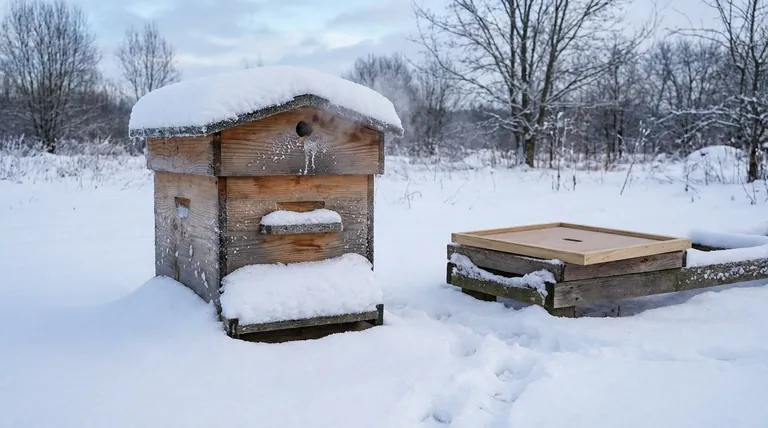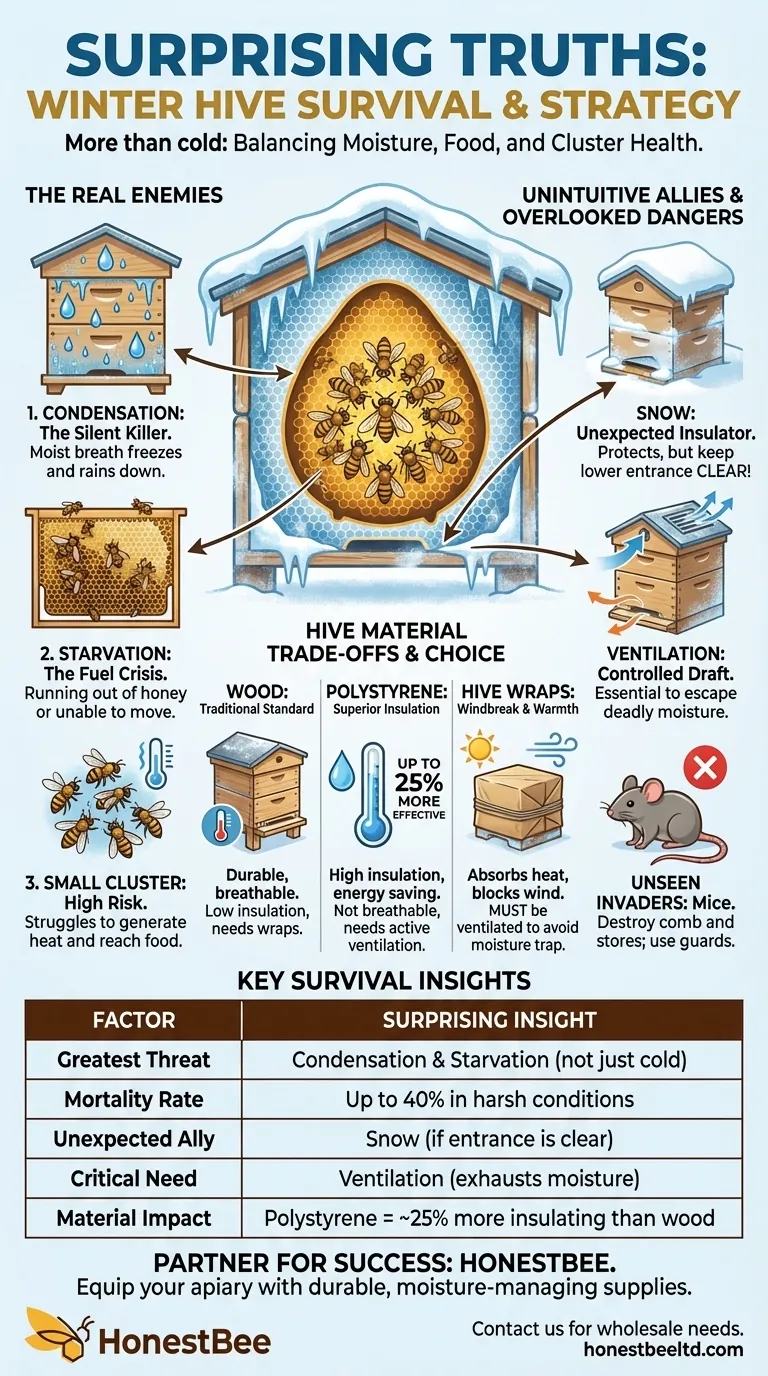Contrary to popular belief, a honeybee colony's greatest winter threat isn't the cold itself, but rather a combination of moisture and starvation. While mortality rates can reach a staggering 40% in harsh conditions, understanding the hive's internal dynamics reveals that simple interventions, like providing ventilation or even allowing snow to accumulate, can be more effective than just adding insulation.
The core challenge of wintering a honeybee colony is not a battle against temperature, but a careful balancing act. Success depends on managing the hive's internal moisture and ensuring the colony has constant access to its food supply.

The True Enemies of a Winter Hive
Beekeepers often focus exclusively on temperature, but the real threats are more subtle and interconnected. A healthy, well-fed colony can generate its own heat; what it cannot easily manage is condensation and isolation.
The Silent Killer: Condensation
Bees consume honey and respire, releasing warm, moist air. When this air hits a cold inner cover or hive wall, it condenses into water droplets.
This cold "rain" can fall directly onto the winter cluster, chilling and killing the bees far more effectively than the outside air temperature. Proper ventilation is the only way to exhaust this moisture.
The Fuel Crisis: Starvation
A winter cluster consumes honey to generate the heat needed for survival. They start at the bottom of the hive and slowly eat their way upwards.
If the cluster is too small or the winter is too long, they can simply run out of fuel. A hive can also starve with honey still present if the cluster is unable to move to a new frame of food during a prolonged cold spell.
The Danger of a Small Cluster
Colony size is critical. A large, populous colony has the workforce needed to form a tight cluster, shiver their flight muscles, and generate significant heat.
A small cluster struggles to maintain its core temperature. This makes it more susceptible to cold, forces it to consume honey at a faster rate, and increases the risk of being unable to move to new food stores.
Unintuitive Allies & Overlooked Dangers
Some of the most effective wintering strategies are counter-intuitive, while some of the biggest threats are easily overlooked.
Snow: An Unexpected Insulator
A blanket of snow can act as an excellent natural insulator, much like an igloo. It shields the hive from chilling winds and helps stabilize the internal temperature.
The crucial caveat is that the hive's lower entrance must remain clear. Blocking the entrance prevents ventilation and can trap deadly moisture inside. It also blocks the bees' path for "cleansing flights" on warmer days.
Ventilation: Why a Draft Can Save a Hive
While you must protect a hive from harsh winds, a small, controlled draft is essential for survival. An upper entrance or a ventilated inner cover allows the warm, moist air to escape.
This prevents the deadly condensation from forming and raining down on the bees. Many hive wraps are designed with an upper hole specifically for this purpose.
The Threat of Unseen Invaders
Mice seek warmth and food in winter and find a beehive to be an ideal home. They can quickly destroy comb, consume honey stores, and foul the hive.
A simple entrance reducer or mouse guard installed in the fall is a non-negotiable piece of equipment that prevents this destructive invasion.
Understanding the Trade-offs in Hive Materials
Your choice of hive body impacts insulation and moisture management, creating a series of trade-offs you must manage.
Wood: The Traditional Standard
Traditional wooden hives are durable and breathable, which can help with passive moisture management. However, their insulation value is relatively low.
In cold climates, wooden hives almost always require supplemental insulation, such as hive wraps or rigid foam boards, to reduce heat loss.
Polystyrene: Superior Insulation
Polystyrene hives offer significantly better insulation—up to 25% more effective than traditional wood. This reduces the colony's energy consumption and can improve survival rates.
The trade-off is that these hives are not breathable. This makes active moisture management and proper ventilation even more critical to prevent condensation buildup inside the non-porous walls.
Hive Wraps: More Than Just Insulation
Wrapping a hive, often with black tar paper or plastic, serves two functions. It provides a crucial windbreak and absorbs solar radiation on sunny days, adding warmth.
However, a wrap that is not ventilated becomes a moisture trap. It is essential that the wrap allows for an upper entrance to ensure moist air can escape.
Making the Right Choice for Your Goal
Based on these principles, you can tailor your wintering strategy to your specific climate and goals.
- If your primary focus is a cold, snowy climate: Prioritize a well-insulated hive and ensure the bottom entrance remains clear of snow to maintain ventilation.
- If your primary focus is a damp, wet climate: Make moisture control your top priority by using a ventilated inner cover or providing an upper entrance.
- If your primary focus is on a weak but viable colony: Ensure they have direct access to food and consider moving them to a smaller, more insulated hive body (a "nuc") that they can heat more easily.
Understanding these interconnected factors empowers you to move beyond simply fighting the cold and instead work with the bees' natural wintering strategy.
Summary Table:
| Key Winter Hive Factor | Surprising Insight |
|---|---|
| Greatest Threat | Condensation & Starvation, not the cold itself. |
| Mortality Rate | Can reach 40% in harsh conditions. |
| Unexpected Ally | Snow acts as a natural insulator (if the entrance is clear). |
| Critical Need | Ventilation to exhaust moisture-laden air. |
| Material Impact | Polystyrene hives can be 25% more insulating than wood. |
Equip your apiary for winter success with HONESTBEE.
As a trusted supplier of beekeeping supplies and equipment for commercial apiaries and distributors, we understand the critical balance required for winter hive survival. Our durable equipment, from ventilated inner covers to effective mouse guards, is designed to help you manage moisture and prevent starvation.
Ensure your colonies have the right tools to thrive. Contact HONESTBEE today to discuss your wholesale needs and build a more resilient operation.
Visual Guide

Related Products
- Inner Beehive Cover for Beekeeping Bee Hive Inner Cover
- Professional Insulated Winter Hive Wrap for Beekeeping
- Professional Galvanized Hive Strap with Secure Locking Buckle for Beekeeping
- Professional Grade Foldable Beehive Handles
- HONESTBEE Classic Pry Bar Hive Tool with High Visibility Finish for Beekeeping
People Also Ask
- What is an inner cover in a beehive and what are its features? A Key Tool for Hive Health & Management
- What is the function of an inner cover in a beehive? Essential for Hive Health & Management
- Why might beekeepers use an inner cover under the telescoping outer cover? Simplify Hive Management & Protect Your Colony
- What is the recommended orientation for the rim of an inner cover? Master Hive Ventilation and Insulation
- What are the advantages of using an inner cover in a beehive? Key Benefits for Hive Health & Beekeeper Efficiency



















